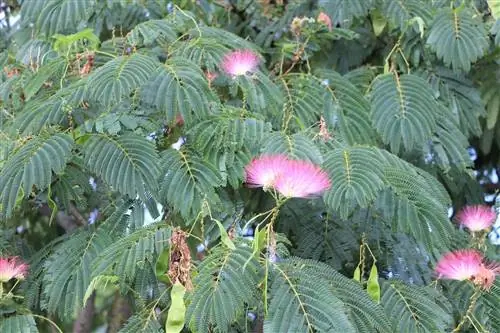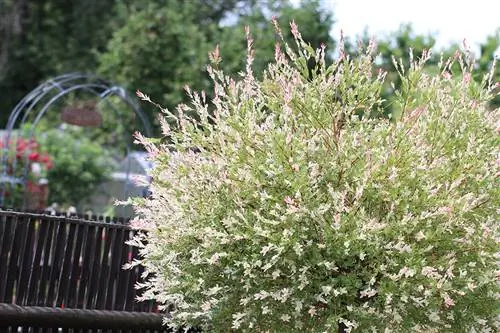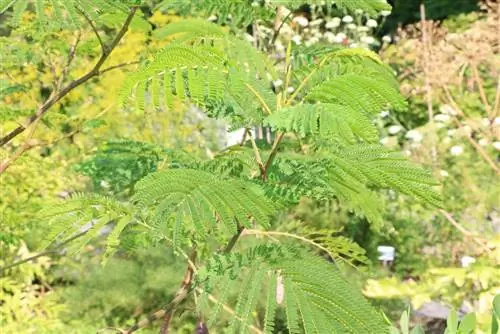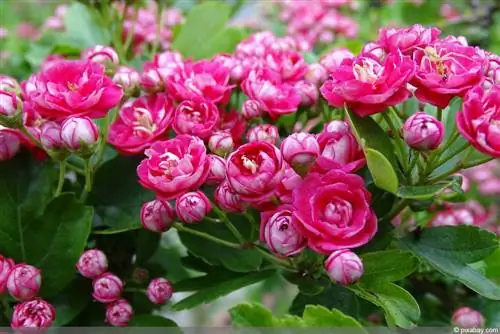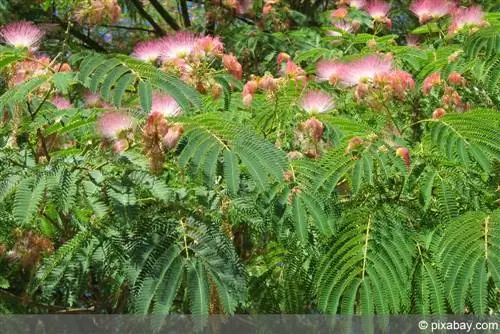- Author admin [email protected].
- Public 2023-12-17 03:39.
- Last modified 2025-01-24 12:45.
Unlike mimosa, the leaves of the sleeping tree do not react to movement. Because of the many silky stamens, similar to powder puffs, it is also called the silk tree or silk acacia. Its original origins are Iran, Pakistan, the Himalayan region, China and Japan.
Location
In our area, the sleeping tree is usually found as a container plant. It has long been popular and widespread as a garden plant in the Mediterranean region. Sun or at least partial shade is preferred as a location. Full sun does not harm it; shade should be avoided. A sheltered location in front of a southern wall of the house would be ideal. In wine-growing regions, for example the Rhine Valley, the sleeping tree survives the cold season unscathed.
From minus 15 degrees, young plants in particular should receive winter protection. A layer of leaves can protect the root area and fleece or a coconut mat wrapped around the trunk will ward off excessive cold. If the tree is older, its resistance to frost increases. It can also be used as a potted plant in the winter garden.
The soil should be permeable and humus-rich, possibly sandy with some gravel added. It needs moist soil and the root ball must not dry out. However, waterlogging should be avoided.
Growth behavior
- The growth as well as the leaves and fruits are somewhat reminiscent of the robinia, but overall the sleeping tree appears more delicate.
- The tree grows quite quickly and can gain up to 50 cm in height per year.
- Compared to other trees, it is rather short-lived, living up to 30 years.
- The crown forms itself like an umbrella, flat and broadly spreading. Therefore, tree trimming is not necessary.
- Specimens that have become too large can easily be shortened. They take no damage.
- The shoots of the tree are angular and bare.
- The tips of young specimens are cut several times so that the plant branches more abundantly.
Leaves, flowers and fruits
The bipinnate, delicate leaves have long stalks and are between 20 and 30 cm long. They are hairy on the lower side along the midrib. The leaves are mimosa-like and sway with every gentle breeze, creating cheerful plays of light and shadow. In autumn the leaves are shed.
The countless flowers give the tree a delicate beauty in the summer months of July to the end of August. They look like bright pink, red or white balls about 3 cm in size and emit a light scent. Numerous butterflies and bees are attracted to it. The fruits, similar to a pea pod, are approximately 15 cm long. A new silk tree can be grown relatively easily from them.
Care
The sleeping tree is very easy to care for. You can tell from the leaves whether the sleeping tree is lacking water, because then they fold up, just like in the evening. This prevents excessive evaporation. The tree needs a lot of light, ideally full sun. It reacts to a lack of light by dropping its leaves and suddenly looks almost dead, but quickly sprouts again when growing conditions are more favorable.
During the growth phase, fertilizer should be applied every two weeks.
If the sleeping tree is given a place in the garden, it should not be placed near ponds or pools because of the abundance of leaves it sheds. The light and fragile wood cannot withstand storms either. In the cold season, the ground around the trunk is covered with a layer of mulch or fir branches. To prevent cracks from forming on the trunk, it should be wrapped with fleece or jute to protect it from sunlight in winter.
Growing from seeds
A young plant can be grown relatively easily from seeds. The seeds are soaked overnight in water at around 28 degrees. After a day they will have swollen significantly and can be placed in small pots with potting soil. The best conditions are in an indoor greenhouse or the pot covered with cling film. Regular watering should be ensured during cultivation. Once the first leaves have formed, the small plant is transplanted into pots. Sowing on the windowsill can be done from February to summer.
Diseases and pests
The sleeping tree is hardly susceptible to diseases and pests. Due to incorrect care, it quickly sheds its leaves. Once this is remedied, it will sprout again quickly. Even a slight pest infestation indicates the wrong location. Small trees are washed with soapy water. In the garden, pests are eliminated naturally by predators.
What you should know in brief
- The sleeping tree is a beautiful and unusual plant and attracts everyone's attention. The flowers shine like silk.
- Growing is easy and the tree grows quickly. Suitable for balconies and terraces with winter protection.
- The sleeping tree got its German name from the fact that its leaves are folded up in the evening.
- A plant that is absolutely easy to grow from seeds and grows relatively quickly.
- From the second year onwards, the sleeping tree is also hardy in mild areas.
- In the first year it can stay outside, but here you should still provide sufficient frost protection, especially in the root area.
- The sleeping tree loves humus-rich, deep soil, without waterlogging.
Although it sounds like the sleeping tree is easy to care for, unfortunately it is not: it requires a lot of care and a lot of attention. Plenty of water is just as important as a sense of when enough is enough. The mistake you often make, especially with young plants, is that you literally drown them. The soil should always be moist, but never wet. Waterlogging is just as difficult to tolerate as drought. A he althy average should be achieved here. However, the probability that the sleeping tree will be affected by pests or diseases is extremely low. Leaf drop should not be a cause for alarm; as the leaves fall, new leaves emerge quickly. However, leaf drop could mean a sign of lack of light. If the plant does not produce new leaves soon, it would be an advantage to move the plant to a location where it gets significantly more light.
- small tree up to 10 meters, legume
- the leaves: summer green stalked with fine leaflets that are folded up at dusk as a special feature.
- At the end of twilight the leaves are put up again.
- fine, pink flowers up to 3 cm, very numerous from July to the end of August
- full sunny location preferred, high water requirement, water more sparingly in winter
- suitable for pot cultivation in the garden, ideal for overwintering in the greenhouse at around 10 degrees, young plants need winter protection
- fertilizer applications from spring to the end of September

